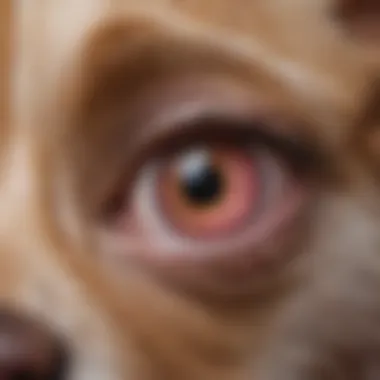Home Remedies for Treating Pink Eye in Dogs


Intro
Pink eye, also known as conjunctivitis, is a common eye condition in dogs that can cause significant discomfort. Addressing this issue promptly and effectively is essential for the overall health of our canine companions. Understanding what causes pink eye, how to recognize its symptoms, and knowing the home remedies available for treatment can help pet owners manage this condition more effectively. This article aims to provide you with a comprehensive guide to treating pink eye at home with practical solutions.
Fascinating Facts About the Dog
Unique Characteristics
Dogs, as a species, share various traits that differentiate them from other animals. For example, their extraordinary sense of smell contributes to their ability to detect certain eye issues, including pink eye, even before symptoms manifest. This instinctual behavior often alerts the owner to potential health problems.
Extraordinary Abilities
Dogs possess an incredible capacity to learn and adapt. Their eyes, although structurally different from those of humans, allow them to perceive a wide spectrum of colors. This capability gives them an edge in understanding their surroundings and noticing subtle changes in their health, making them vigilant companions.
Understanding Pink Eye in Dogs
Causes of Conjunctivitis
Several factors can lead to pink eye in dogs:
- Allergies: Environmental triggers such as pollen, dust, or mold can irritate the eyes.
- Infections: Viral or bacterial infections can cause inflammation and discomfort.
- Foreign Objects: Dirt, sand, or other debris can become lodged in the eye, causing irritation.
- Underlying Health Issues: Conditions affecting the immune system or other systemic problems may also lead to conjunctivitis.
Symptoms to Observe
Signs that may indicate your dog has pink eye include:
- Red or pink-toned eyes
- Excessive tearing
- Swelling of the eyelids
- Discharge that may be clear or pus-like
- Squinting or increased sensitivity to light
It is vital to consult a veterinarian if symptoms persist or worsen, as these could lead to more severe health concerns.
Home Remedies for Alleviating Symptoms
Before attempting any home treatment, it is essential to observe the dog's symptoms carefully. Here are some methods to consider:
- Warm Compresses: Applying a warm, moist cloth to the affected eye can soothe irritation.
- Saline Solution Rinse: A homemade saline solution can help flush out irritants. Mix one teaspoon of salt in a cup of lukewarm water.
- Honey Drops: Raw honey has natural antibacterial properties. Dilute honey with water and apply a few drops to the affected eye.
It is necessary to note that not every remedy will work for every dog, and professional vet input is quite valuable.
When to Seek Professional Help
If home treatments do not yield improvement within two to three days, or if your dog displays increased discomfort or additional symptoms, immediate veterinary care is crucial.
Ending
Understanding Pink Eye in Dogs
Understanding pink eye in dogs is crucial for any pet owner. It enables one to identify the symptoms early and take appropriate action to alleviate discomfort for the pet. Pink eye, or conjunctivitis, can lead to severe issues if left unchecked. By grasping the condition's nuances, pet owners can better handle symptoms at home, providing relief and promoting recovery.
Definition of Pink Eye
Pink eye in dogs is an inflammation of the conjunctiva. The conjunctiva is a thin layer that covers the inside of the eyelids and part of the eye's surface. When this area becomes inflamed, the dog may exhibit symptoms like redness and discharge. Recognizing this condition is the first step in providing effective care.
Common Causes of Pink Eye
Irritants and Allergens
Irritants and allergens are among the most prevalent causes of pink eye. They include dust, pollen, smoke, or harsh chemicals that may come into contact with a dog's eyes. Such incidences can lead to an allergic response, causing redness and swelling. Being aware of these factors can help pet owners mitigate their dog's exposure to potential irritants and allergens. This can provide immediate relief and prevent recurrences.
Bacterial Infection
Bacterial infection is another common cause of pink eye in dogs. The presence of harmful bacteria can lead to infection and inflammation of the conjunctiva. It is critical to recognize that bacterial conjunctivitis can be contagious among pets. Thus, identifying this cause early on is essential for preventing the spread to other animals. An effective home treatment may include cleaning the affected area, though veterinary intervention may be necessary for resolution.


Viral Infection
Viral infection can also lead to pink eye in dogs. Viruses can cause conjunctivitis, similar to how they affect humans. The unique aspect of viral conjunctivitis is that it typically accompanies other symptoms like nasal discharge or coughing. Here, a careful observation of associated signs is key. While some viral infections may clear without specific treatment, ongoing symptoms may require veterinary assistance.
Foreign Bodies and Trauma
Foreign bodies and trauma represent another significant cause of pink eye. Anything that enters the eye, such as dust, grass, or other foreign materials, can lead to irritation and inflammation. Moreover, injuries to the eye itself can contribute to conjunctivitis. Promptly addressing any signs of trauma is critical. Removing a foreign object might be possible at home, but severe injuries often necessitate professional care.
Risk Factors
Recognizing the risk factors associated with pink eye can aid in prevention and timely management. Certain dog breeds may be more susceptible due to their anatomical structure. Environmental factors, such as living in urban areas with pollutants, also play a role. Additionally, previous health history can impact a dog's risk. Keeping these factors in mind allows for better awareness and proactive measures to safeguard a dog’s eye health.
Recognizing Symptoms of Pink Eye
Recognizing symptoms of pink eye in dogs is crucial for early intervention and effective home treatment. Understanding these signs allows pet owners to act swiftly, which can minimize discomfort for the dog and potentially prevent further complications. The presence of symptoms can vary in intensity and may indicate the underlying cause of conjunctivitis. Therefore, accurate observation is key.
Visual Indicators
Redness and Inflammation
Redness and inflammation are among the primary symptoms of pink eye. This can manifest as noticeable redness in the white part of the eye or the eyelids. The inflammation signifies an underlying issue, often related to infection or irritation. This symptom serves as an important identifier for pet owners, as it suggests that something is amiss.
The critical characteristic of this symptom is its visibility. It is easy for pet owners to see and recognize. Since redness and inflammation can progress, acting quickly can mitigate discomfort for the dog. However, it is vital to note that while redness is a common symptom, other underlying issues could also cause it, thus requiring further observation.
Excessive Tearing
Excessive tearing is another indicator that could signal pink eye. This symptom occurs when the eyes produce more tears than usual—often a body's response to irritation. Pet owners might notice wetness around the eyes or increased tear staining.
The primary feature of excessive tearing is that it can occur alongside other visual symptoms. This can provide nuanced insights into the dog's condition. However, this symptom alone may not always indicate pink eye. It can also be a sign of allergies or other eye concerns, which is crucial to consider when evaluating the situation.
Discharge
Discharge from the eye is perhaps one of the more alarming symptoms of pink eye. It can present as a yellow, green, or clear fluid. The type of discharge often provides insight into whether an infection might be bacterial or viral. Thus, understanding this symptom is significant in determining the appropriate course of action.
The key characteristic of discharge is its variability; it can range from mild to severe. It can guide pet owners in seeking treatment. Noticing changes in the consistency and color of discharge can indicate worsening conditions. Therefore, monitoring this symptom is essential.
Behavioral Changes
Rubbing Eyes
When a dog rubs its eyes, it often indicates discomfort or irritation. This behavior is sometimes a response to the symptoms of pink eye, such as itchiness or pain. Owners should pay attention to this behavior as it may worsen the condition. Dogs often use their paws to alleviate discomfort, leading to further irritation.
The key aspect of this symptom is its frequency. When a dog consistently rubs its eyes, it suggests a need for immediate attention. However, while this behavior can indicate issues, it may also reflect habits formed due to other environmental factors. Thus, context and other symptoms should be evaluated simultaneously.
Squinting or Blindness
Squinting or noticeable difficulty in opening the eyes can suggest pain or severe discomfort due to pink eye. In some cases, this behavior may even indicate more serious conditions that could lead to blindness. Ensuring the dog's comfort and preventing further injury is critical.
The primary feature of squinting is its noticeable nature. It can often be one of the first behavioral signs observed by owners. This symptom can also indicate underlying inflammation or pain. Understanding it allows owners to better assess the urgency of the situation and the need for treatment.
Recognizing these symptoms not only aids in treatment but also indicates when a vet’s intervention is necessary.
Initial Home Observations
Initial home observations play a critical role in managing pink eye in dogs. Understanding how to monitor your pet's symptoms and assess the severity of their condition can guide you in providing effective home care. This initial assessment not only helps in determining the next course of action but also ensures that your dog's well-being is prioritized.
Monitoring Symptoms
Monitoring symptoms is essential for recognizing changes in your dog's condition. Regular observation allows pet owners to track any developments or improvements, providing valuable information for either home treatment or for your veterinarian. Take note of the following aspects when monitoring:
- Frequency of Eye Discharge: Note whether there's an increase or change in the type of discharge, such as clear, cloudy, or colored.
- Level of Redness: Observe the extent of redness or inflammation in the eye area, which can indicate worsening conditions.
- Behavioral Changes: Pay attention to how your dog reacts to bright lights or sudden movements. Increased squinting or rubbing may signal discomfort.


Keeping a daily log of symptoms can be helpful. This can also aid your veterinarian if medical intervention becomes necessary. Consistent monitoring brings awareness to the intricacies of your pet's condition and empowers you as a caregiver.
Assessing Severity
Assessing the severity of your dog's pink eye is vital for determining appropriate home treatment and recognizing when professional care is needed. There are several factors to consider:
- Duration of Symptoms: If the symptoms persist beyond a few days without improvement, this could indicate a more serious underlying issue.
- Response to Home Care: Evaluate whether any initial home remedies are showing signs of effectiveness. Lack of improvement often necessitates a more significant course of action.
- Presence of Pain: Signs of discomfort such as excessive squinting or refusal to open the eye may indicate a severe infection or injury.
In cases where the symptoms are worsening, or if there's a sudden change in your dog’s behavior, it may be time to consult a veterinarian. Knowing how to accurately assess severity can prevent potential complications and ensure your dog receives timely care when necessary.
Prompt observations can make a significant difference in your dog's recovery journey, allowing for meaningful interventions at the appropriate time.
Home-Based Treatment Options
Home-based treatment options are crucial for pet owners dealing with pink eye in dogs. These methods provide immediate, accessible solutions that can be administered in the comfort of one's home. Recognizing the symptoms and employing appropriate treatments can often alleviate discomfort and foster recovery. Notably, utilizing home remedies can also serve as a preventive measure against the escalation of the condition, minimizing the need for veterinary interventions.
Cleaning the Affected Eye
Use of Saline Solution
Using saline solution is an effective way to clean the affected eye in dogs experiencing pink eye. This solution helps to flush out any debris or irritants that may be causing discomfort. The key characteristic of saline is its ability to mimic the natural fluids of the body, making it gentle on sensitive eyes. Its nearly universal availability in pharmacies adds to its popularity among pet owners.
One unique feature of saline solution is that it is designed to not irritate the eye further, which is crucial when treating inflammation. However, it is important to ensure that the saline solution is sterile. Distilled saline or pre-packaged sterile saline is preferable to avoid introducing any additional contaminants. The main advantage is that it is simple to use, but it might not address underlying infections.
Applying Warm Compresses
Applying warm compresses can effectively soothe an irritated eye. The warmth helps to relax tissues and improve blood circulation around the eye area. A key characteristic of this method is its ability to provide immediate comfort to the dog. The warmth can also aid in loosening any crust or discharge that may have formed due to pink eye.
This method is beneficial as it is easy to apply and requires minimal materials, typically just a clean cloth and warm water. A unique feature of warm compresses is their ability to provide both comfort and potential relief from discomfort. However, one must be cautious about the temperature to avoid burning the skin and eyes of the dog. Additionally, its effect is often temporary, so it may need to be repeated throughout the day.
Natural Remedies
Chamomile Tea
Chamomile tea is known for its anti-inflammatory properties, making it a useful remedy for pink eye in dogs. This natural method can help reduce irritation and calm the surrounding tissues. The key characteristic of chamomile tea is its gentle and soothing nature, which has been recognized for centuries.
One unique feature of chamomile is its potential to also help with relaxation for the dog, reducing stress during treatment. It is relatively easy to prepare, requiring only steeping chamomile in hot water and then allowing it to cool before applying. While it is generally safe, always ensure the dog is not allergic to chamomile before usage. Its gentle properties are advantageous, but it should not replace veterinary care for severe cases.
Apple Cider Vinegar Dilution
Apple cider vinegar dilution is another popular home remedy used for treating pink eye. This method can help to balance the pH level of the eye and reduce irritation. The key characteristic of this remedy is its antimicrobial properties, which can assist in controlling mild infections.
When diluted properly, apple cider vinegar can be a cost-effective option for pet owners. A unique feature is its versatility, as it can also serve as an aid in overall eye health. However, it is crucial to use the correct dilution ratio to avoid causing further irritation. The advantage lies in its natural approach, but improper use could lead to discomfort.
Topical Treatments
Over-the-Counter Options
Over-the-counter options provide a variety of treatments that can be easily accessed for managing pink eye in dogs. Items often include medicated eye drops or ointments that can reduce inflammation and combat infection. The key characteristic of these options is their formulation, which is typically designed for ease of use in pets.
One unique feature of over-the-counter medications is that they often come with clear instructions for application, making them accessible even to novice pet owners. The advantage is their targeted action, yet it is important to read the ingredients closely. Some dogs may have sensitivities, which could lead to an adverse reaction if not chosen carefully.
Eye Drops for Dogs
Eye drops formulated specifically for dogs are a tailored approach to treating pink eye. These drops can offer relief from symptoms and help manage any underlying issues such as dryness or irritation. The key feature of dog-specific eye drops is their precise formulation, which is safe and effective for canine use.
One unique aspect of these products is their targeted application—designed to be easy for pet owners to administer. It is crucial to select drops that are specifically made for dogs, as human eye drops may not always be suitable. Their benefits include quick absorption and alleviation of symptoms, while potential downsides may include allergies or sensitivity to certain ingredients.
Always consider consulting with a veterinarian before using any home treatment option for pink eye. In some instances, professional intervention may be necessary.
Preventive Measures


To effectively manage pink eye in dogs, preventive measures are crucial. Taking proactive steps can reduce the likelihood of infection and limit future occurrences. Understanding these measures is essential for all pet owners who wish to keep their dog’s eye health intact while avoiding unnecessary veterinary visits.
Hygiene Practices
Maintaining proper hygiene is fundamental in preventing pink eye. Regularly washing your dog’s face and eyes can help remove potential irritants. Use a clean, damp cloth to gently wipe around the eye area, especially after outdoor play. This practice not only prevents the buildup of debris but also reduces the risk of bacterial growth that may lead to infections. Additionally, ensure that bedding and toys are clean, as these can harbor dust and allergens.
Regular Vet Check-Ups
Regular veterinary check-ups are vital for early detection of any eye-related issues. A vet can provide professional insights and tailored advice for maintaining your dog's eye health. Routine exams help in identifying potential irritants or underlying conditions that could lead to pink eye. Early treatment usually results in better outcomes and may prevent the need for more serious interventions later.
Environmental Control
Controlling the dog's environment can significantly minimize the chances of developing pink eye. This approach involves two main strategies: reducing allergens and minimizing irritants.
Reducing Allergens
Reducing allergens in the home environment is a key preventive measure. Common allergens like pollen, dust mites, and pet dander can provoke allergic reactions, leading to pink eye. Keeping windows closed during high pollen seasons and using air purifiers can help mitigate these allergens. Regular vacuuming and dusting also contribute to a cleaner environment, lessening potential eye irritations for your dog. This step is beneficial because it not only helps with eye health but also improves overall quality of life for both the pet and the owner.
Minimizing Irritants
Minimizing irritants is another significant aspect of environmental control. These can include smoke, strong odors, and harsh chemicals found in cleaning products. Opting for pet-safe cleaning supplies and ensuring proper ventilation when using any sprays or chemicals is essential. Limiting exposure to such irritants can lower the risk of inflammation and discomfort in your dog's eyes. A clean environment can prevent the development of pink eye and ensure your dog's eyes remain healthy and clear.
Important Note: Always monitor your dog's reactions to environmental changes. If symptoms arise, reassessing the home environment may be necessary to identify potential sources of irritation.
When to Consult a Veterinarian
Understanding when to seek professional help for your dog’s pink eye is crucial. While many cases can be managed at home, some conditions require veterinary intervention. Knowing the signs that indicate the need for a vet can ensure better health outcomes for your pet and avoid more severe issues.
Persistent Symptoms
If your dog's symptoms of pink eye persist beyond a couple of days, this is a clear indicator that you should consult a veterinarian. Continuation of redness, excessive tearing, or noticeable discharge despite home treatment suggests that the condition may not be just common conjunctivitis.
Persistent symptoms may imply an underlying issue such as:
- Bacterial or viral infection that needs prescription medication.
- An allergic reaction requiring specific treatments.
- A foreign body lodged in the eye that could lead to further irritation or damage.
Ignoring these warnings can lead to complications, so it is essential to seek professional advice if symptoms do not improve.
Signs of Pain or Distress
Observing your dog closely is important. Signs of pain or distress can include behaviors such as:
- Constant pawing at the eyes.
- Avoidance of bright lights or squinting.
- Decreased appetite or lethargy.
If you notice these signs, do not wait too long to contact your veterinarian. Pain can indicate serious health issues that require immediate attention, such as:
- Corneal ulcers that can cause severe pain and vision loss if untreated.
- Uveitis, which is inflammation in the eye’s interior.
- Other systemic conditions that may manifest through eye symptoms.
A veterinarian can provide necessary diagnostics and treatment options to address the root cause of the distress, leading to more effective recovery for your pet. Always prioritize your dog's well-being by being vigilant and proactive in seeking medical help when appropriate.
Concluding Thoughts
In this article, we explored the critical topics concerning the treatment of pink eye, or conjunctivitis, in dogs. Understanding the symptoms, causes, and home remedies can empower pet owners to manage this condition effectively. It is essential to grasp that while home treatments may alleviate symptoms, they are not a substitute for professional veterinary care when necessary.
Recap of Treatment Strategies
To properly address pink eye at home, consider the following strategies:
- Saline Solutions: Cleaning the eye with saline can remove irritants and reduce inflammation.
- Warm Compresses: Applying warmth can soothe discomfort and promote drainage.
- Natural Remedies: Options such as chamomile tea or diluted apple cider vinegar may be beneficial in certain cases. Always check with a vet first.
- Topical Treatments: Over-the-counter eye drops formulated for dogs may provide further relief.
Each treatment comes with its own set of considerations, and observing the dog’s response is crucial. If symptoms persist, a consult with a veterinarian is the best path forward.
Long-term Eye Health Considerations
Maintaining long-term eye health for dogs involves proactive steps:
- Regular Check-ups: Schedule routine veterinary visits to monitor eye health.
- Proper Hygiene: Keep your dog's eyes clean and free from allergens. Wipe away discharge promptly.
- Environmental Management: Reduce exposure to allergens and irritants in their surroundings.
By proactively addressing these factors, pet owners can contribute to their dog’s ongoing eye health. With proper knowledge and care, it is possible to minimize the risk of recurrence and ensure a happy, healthy pet.





